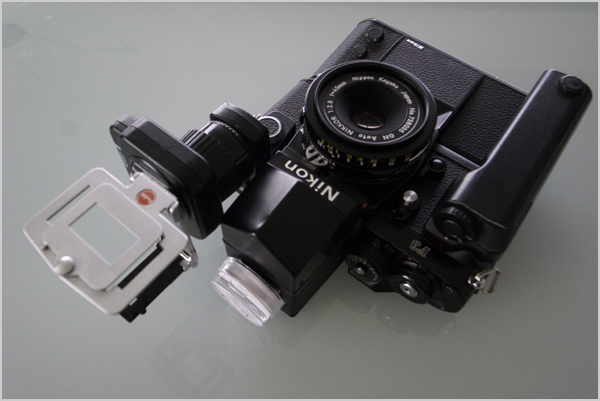
In this pile of stuff is a small, lightweight camera.
Someone takes a camera that is functional and has an elegant (or more accurately, utilitarian design) and makes a Rube Goldberg contraption out of it. Choose from some of the following:
— Accessory finder (12mm, 15mm, 21mm, 25mm, 28mm - three styles, 35mm, 40mm, 50mm, 75mm, 90mm)
— Double accessory shoes (3 styles)
— Pistol grips (3 styles)
— Right-angle finder with inserts for multiple focal lengths
— Spirit level viewfinder
— Trigger winder
— 18-35mm zoom viewfinder
And that's just the list of accessories that Cosina alone has sold in the past five years (so it says nothing about what everyone else is selling). The 35mm rangefinder that was prized because it was compact, fast-shooting, and intuitive is now junked up with projecting parts and more complicated operation.* I would suggest five points:
1. Get over your fear of SLRs. For nearly any specific purpose, SLRs are better than rangefinders - but particularly those uses that motivate rangefinder owners to tart up their cameras. True macro lenses are superior to auto-ups. A through-the-lens viewfinder dispenses with the pantheon of expensive accessory finders. A grid screen wipes out the need for a separate bubble level viewfinder. And an integral motor drive eliminates the need for a trigger winder. There is a reason why the Nikon F simply crushed the German rangefinder industry. It was adaptable and practical multi-mission camera.
2. Accessories get lost and left behind. The only thing sadder than an $800 Leica Universal Finder M would be accidentally leaving it somewhere. Or forgetting to pack it in the first place.
3. Accessories slow you down. The problem with accessory finders and levels is that unless you are willing to live with zone focusing (why buy such expensive glass then?), it takes additional steps to take the shot.
4. Accessories make the camera bigger. A small SLR and an M camera are very close to the same size. There is a persistent myth that rangefinders are smaller, but it's a bit silly (and probably a bit of conventional wisdom that came about when the Reflex-Korelle was popular). The minimum size of a 35mm camera is defined by a 35mm film canister, a 24x36mm film gate, and a takeup spool. The only difference beyond that is in a pentaprism bulge and lens size - and those can both be very small. Do some measuring, and you'll see that a rangefinder camera bristling with accessories (or even with a single accessory finder) can actually be bigger than a typical film SLR.
5. Accessories are not cost effective for most users, but manufacturers and dealers love to sell them. Manufacturers love to sell them because they command prices that are disproportionate to the cameras they fit on. Consider that right after the Bessa R2 came out, you could buy a Bessa R at retail for $250 - but an accessory finder (basically any focal length) sold for $100. It's two pieces of glass and a plastic housing vs. an entire camera with a rangefinder system, winding mechanism, shutter, etc. in it. It doesn't take a course in business to understand where the profit is. This is the ready explanation for the endless mill of accessories from Cosina (Voigtlander, Zeiss, or whatever brand Cosina has most recently body-snatched). Dealers, for their part, love to sell accessories (finders, filters, cases, straps) because the markups are large. They might not make anything on selling the camera (maybe a couple of points) - but they can score big selling all the trinkets that go with it. There is nothing morally wrong with this - it's the way all equipment dealers work, including car dealers. But understand that camera dealers have a big interest in pushing as much of this stuff as possible - even if it operates against your ability to get the shot quickly and effectively. Learn to say no. It might sound like the greatest thing since sliced bread, but not from where you are standing.
All of this is not to say that you should never put an accessory in the shoe of your rangefinder camera - but it is to say that when you are doing this more than a small amount of the time, or mounting multiple accessories, you should consider whether you are even using the right tool for the job.
-------------------
*This is obviously not a consideration with medium-format rangefinders, which are huge, heavy, relatively slow to use, and rarely elegantly designed. Mounting an accessory viewfinder (or anything else) would in no way inhibit their pocketability or efficiency.